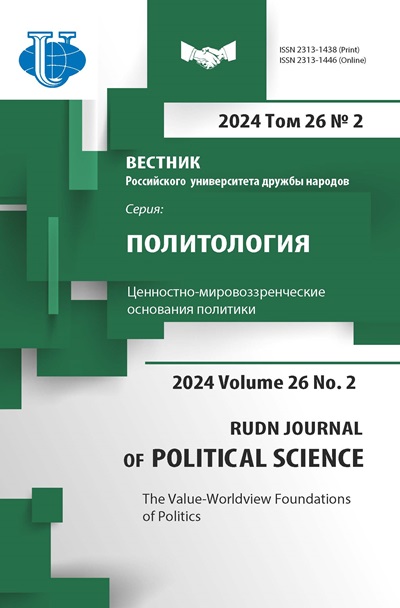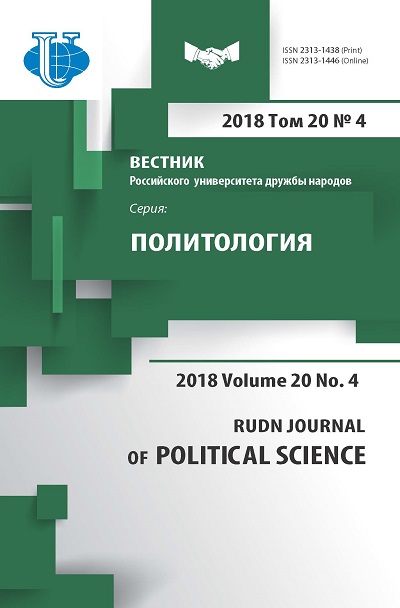MANUFACTURING CONSENT... OR HEGEMONY? BOOK REVIEW: Kilani A. Comparative Analysis of Media Hegemony: Propaganda and Manufacturing Consent in U.S. Media. Columbia: SC; 2018. 166 p
- Authors: Ivanov V.G.1, Efanova E.V.2
-
Affiliations:
- Peoples’ Friendship University of Russia (RUDN University)
- Volgograd State University
- Issue: Vol 20, No 4 (2018)
- Pages: 630-633
- Section: Scientific reviews
- URL: https://journals.rudn.ru/political-science/article/view/20406
- DOI: https://doi.org/10.22363/2313-1438-2018-20-4-630-633
Cite item
Full Text
Abstract
This year's monograph by young Lebanese political scientist Ahmad Kilani “Comparative analysis of media hegemony: propaganda and production of consent in US media” is of both scientific and practical interest to political scientists, political analysts and journalists. The book presents a comparative study of theoretical and conceptual approaches to analyzing and substantiating media hegemony in the United States. Drawing on the analysis of various research theories and concepts, including various historical and modern cases, the author comes to meaningful conclusions that could be of interest to a wide range of readers.
Keywords
Full Text
The book “Comparative Analysis of Media Hegemony” [1] is a study of contending theories in the fields of media and political science. Essentially, the book is an attempt to single out a theory which better explains how American propaganda and media hegemony work. The author, Ahmad Kilani, is a specialist in the field of US foreign policy and media. In his book, Kilani examines propaganda and encoding/decoding models, as well as the theory of inverted totalitarianism, in order to understand how American film media “manufacture consent” for US foreign policy. In addition, the book includes a comparative analysis between hegemonic and non-hegemonic films. Kilani’s ideas are based on the Gramscian theory of cultural hegemony. The first chapter of the book consists of the following sections: introduction, research question, methodology and map of the book. In the second chapter [1. P. 16-55], the author examines the origin of propaganda and hegemony in the US, from the foundation of modern propaganda by Walter Lipmann and the ideas of Edward Bernays to Noam Chomsky’s concept of modern propaganda. The author then proceeds to discuss the roots of hegemony in Antonio Gramsci’s model, moving on to analyze the encoding and decoding model of Stuart Hall and the right-wing authoritarianism scale. The author concludes the chapter with a definition of hegemony, propaganda, and manufacturing consent refined by scholars in the field of hegemony and propaganda. 630 НАУЧНЫЕ РЕЦЕНЗИИ In the third chapter [1. P. 56-75], the author compares two lists of films: pictures produced or distributed by “hegemonic” media corporations and those produced by nonhegemonic media companies. The criteria of distributing films into two groups are the era of production, the production/distribution company, box-office sales, domestic audience percentage, and the gross theater release. As a result of his comparative analysis, the author arrives at conclusion that “hegemonic” films are less subject to criticism and distributed more frequently in theaters. Also he finds that “hegemonic” films promote American exceptionalism and provide justification for US wars. At the end of the chapter, the author examines the cultivation theory to support his argument. According to this theory, the amount of time viewers spend watching television and films directly affects their eagerness to believe in the social reality as portrayed by TV. The fourth chapter [1. P. 76-97] examines the propaganda model suggested by Matthew Alford, who uses his theory to analyze selected Hollywood motion pictures. To account for the ideological output of mainstream Hollywood, Alford applies five filters: concentrated ownership, product placement, sourcing, elite superiority, and a dominant ideology of ‘us’ versus ‘them’. The author considers the propaganda model a solid attempt at explaining how the media function in the US; however, the model is becoming outdated, as the popularity of internet as a major information source grows. Nevertheless, the author stresses that social media are the main alternative source of news, and the latter is also controlled by a number of corporations that have their own agenda and purposes and, hence, can be considered hegemonic as well. In the fifth chapter [1. P. 98-115], the author reviews the theory of inverted authoritarianism, which explains how fear coming from an external threat, social legitimacy and social traditions can be used to manipulate public opinion. Also, the author explains the concept of political imaginary in media, which, in its turn, has two sub-concepts: constitutional imaginary and power imaginary. The first constituent symbolizes sovereignty and law, whereas the second sub-category represents the contrary. The author argues that, in many films, media displays the superiority of power imaginary over the constitutional imaginary, and he gives numerous examples to support his assertion. Finally, after assessing this theory, the author calls it realistic in the way it explains how US foreign policy and media are interrelated; however, the author notes that this theory does not provide any adequate commentary on how the public receives propaganda from the media and whether or not the viewers accept the message. In the next chapter [1. P. 116-133], the author focuses on the encoding/decoding model. This model asserts that not all messages transmitted by the media are accepted by the audience. Therefore, the elite have to adapt their message so that it would meet the social standards of the population. The author emphasizes that films are created in correspondence with the accepted values and norms of the society, and he gives numerous examples to validate his idea. In the final chapter [1. P. 134-156], the author provides a recap of his findings. The author concludes that the three theories are correlated and have a similar concept, and argues that none of the three theories provides an adequate rationale for American media hegemony; instead, they merely demonstrate how hegemonic media works in favor of the elite’s interests. REVIEWS 631 Иванов В.Г., Ефанова Е.В. Вестник РУДН. Серия: ПОЛИТОЛОГИЯ. 2018. Т. 20. № 4. С. 630-633 Overall, “Comparative Analysis of Media Hegemony” is a rather interesting read. It looks at the US foreign policy from a new perspective, which intertwines ideology and political economy. The author makes a strong argument and provides well documented evidence to support it. As for the references used in the research, the author studies an extensive variety of primary and secondary sources, including interviews, articles, journals, films and documents provided by the Department of State, Central Intelligence Agency, and National Security Council. Generally, the book is of certain significance for international relations studies, as it provides an insight into media-politics interconnection. The author makes a significant effort to present a comprehensive analysis of the media hegemony roots from the World War II, to the Cold War, and War on Terror. Therefore, we recommend this book to anyone who is seeking to learn more about U.S. media and its hegemonic tendencies.×
About the authors
Vladimir Gennadievich Ivanov
Peoples’ Friendship University of Russia (RUDN University)
Email: ivanov_vg@pfur.ru
PhD, Doctor of Science, Associate Professor of the Department of Comparative Politics, Peoples’ Friendship University of Russia (RUDN University) Miklukho-Maklaya str. 6, Moscow, Russian Federation, 117198
Elena Vladimirovna Efanova
Volgograd State University
Email: efanova@volsu.ru
PhD, Associate Professor of the Department of International Relations, Political Science and Area Studies, Volgograd State University Universitetskij prosp., 100, Volgograd, Russian Federation, 400062
References
- Kilani A. Comparative Analysis of Media Hegemony: Propaganda and Manufacturing Consent in U.S. Media. Columbia: SC; 2018. 166 p
















